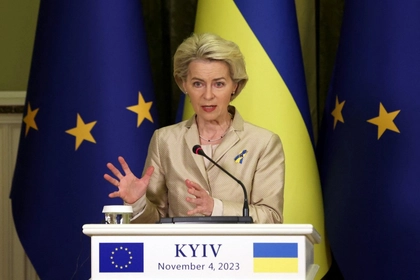Ukraine’s ability to intercept Russian missile attacks has significantly declined in recent months as Russia intensifies its use of drones and missiles, including more difficult-to-target weapons like ballistic missiles, the Wall Street Journal (WSJ) reported.
Compounding the issue, Kyiv is facing shortages of ammunition for its Western-supplied Patriot systems, which have been its main defense against such attacks.
JOIN US ON TELEGRAM
Follow our coverage of the war on the @Kyivpost_official.
The WSJ analysis of daily data from the Ukrainian Air Force Command indicates that Ukraine intercepted only 46% of Russian missiles over the past six months, compared to 73% in the previous six months. Last month, the interception rate dropped to just 30%.
However, the interception rate for long-range Shahed drones, which are easier to shoot down, remained relatively high at 82%.
As reported by WSJ, the increased bombardment is causing significant damage to infrastructure and cities, while depleting Ukraine’s already limited missile supply needed to counter Russia's air force.
US Secretary Antony Blinken acknowledged on CBS News's “Face the Nation” that the delay in congressional approval for Ukraine aid has been costly.
According to European military intelligence sources, the next couple of months will be critical in determining whether Ukraine can fend off Russia’s air force until new Western air defense supplies arrive.
In the past six months, Russia has significantly increased its drone and missile attacks, firing about 45% more than in the preceding period.

EU Transfers €1.5 Bln Raised From Russian Assets for Ukraine
As per the WSJ report, the higher volume of attacks is rapidly depleting ammunition stocks and overwhelming Ukrainian defenses, which sometimes struggle to reload quickly enough to counter large barrages.
Over the past six months, Russia has significantly increased its deployment of Shahed drones, firing almost double the previous amount at 2,628. These drones are believed to serve the purpose of testing air defenses before missile strikes.
In addition to the drones, Russia has fired 114 ballistic missiles and 46 hypersonic Kinzhal and Zircon missiles. This marks a notable increase compared to the previous period, with 33 ballistic missiles and 27 hypersonic missiles launched, according to WSJ.
Moreover, Moscow has repurposed its air-defense systems, such as the S-300 and S-400, to launch attacks on Ukraine. They have fired a total of 175 missiles from these systems into unoccupied Ukrainian territory this year alone.
The Patriot system has been Ukraine's most reliable defense against ballistic and hypersonic missiles, but they have limited supplies, as reported by WSJ. Despite delays in receiving new supplies from the US, they're now set to receive additional Patriot interceptors. However, it will take time for these to be manufactured and deployed.
Ukraine is also exploring other missile-defense options, but they're not as effective against the advanced weaponry being used by Russia. With missile supplies dwindling, the air war may ultimately come down to which side can sustain their attacks longer.
Ukraine relies on Western allies for missile supplies, while Russia has its production capabilities and support from allies like Iran and North Korea, concluded the WSJ.
You can also highlight the text and press Ctrl + Enter






